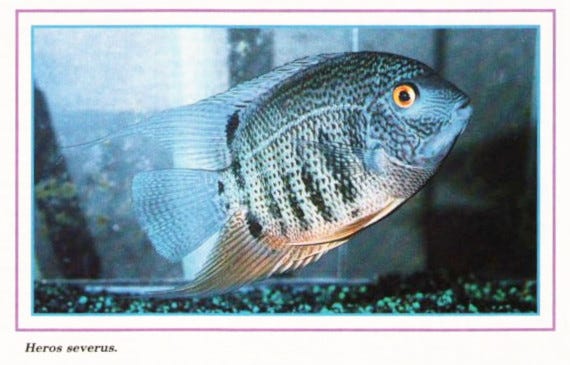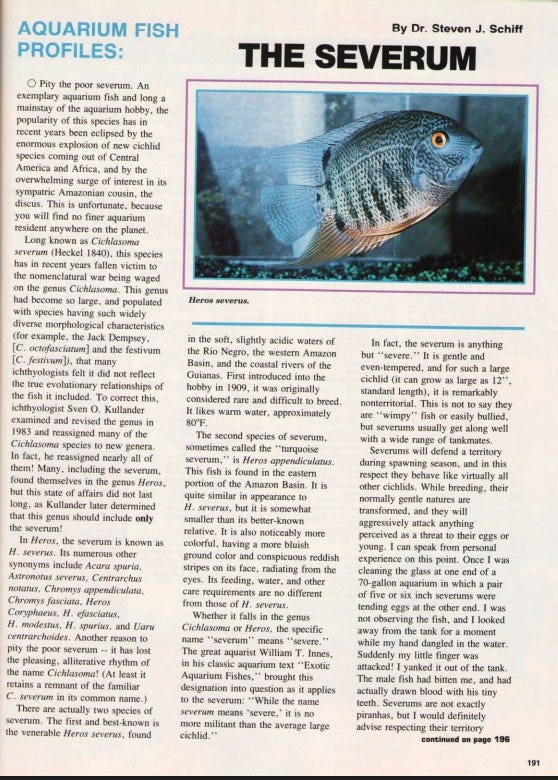This was the first of my “Aquarium Fish Profiles” series. I had written about specific species before, but usually in the context of spawning reports. In this series I wrote about interesting and desirable aquarium fish species that I enjoyed keeping, without the emphasis on breeding them. As you can tell from the article, the severum is one of my all-time favorite aquarium fish species!
This article first appeared in the June 1994 issue of FAMA. Copyright © 2025 by Steven J. Schiff. All rights reserved.
Aquarium Fish Profiles: The Severum
Pity the poor severum. An exemplary aquarium fish and long a mainstay of the aquarium hobby, the popularity of this species has in recent years been eclipsed by the enormous explosion of new cichlid species coming out of Central America and Africa, and by the overwhelming surge of interest in its sympatric Amazonian cousin, the discus. This is unfortunate, because you will find no finer aquarium resident anywhere on the planet.
Long known as Cichlasoma severum (Heckel 1840), this species has in recent years fallen victim to the nomenclatural war being waged on the genus Cichlasoma. This genus had become so large, and populated with species having such widely diverse morphological characteristics (for example, the Jack Dempsey [C. octofasciatum] and the festivum [C. festivum]), that many ichthyologists felt it did not reflect the true evolutionary relationships of the fish it included. To correct this, ichthyologist Sven O. Kullander examined and revised the genus in 1983 and reassigned many of the Cichlasoma species to new genera. In fact, he reassigned nearly all of them! Many, including the severum, found themselves in the genus Heros, but this state of affairs did not last long, as Kullander later determined that this genus should include only the severum.
In Heros, the severum is known as H. severus. Its numerous other synonyms include Acara spuria, Astronotus severus, Centrarchus notatus, Chromys appendiculata, Chromys fasciata, Heros coryphaeus, H. efasciatus, H. modestus, H. spurius, and Uaru centrarchoides. Another reason to pity the poor severum – it has lost the pleasing, alliterative rhythm of the name Cichlasoma! (At least it retains a remnant of the familiar C. severum in its common name.)
There are actually two species of severum. The first and best-known is the venerable Heros severus, found in the soft, slightly acidic waters of the Rio Negro, the western Amazon Basin, and the coastal rivers of the Guianas. First introduced into the hobby in 1909, it was originally considered rare and difficult to breed. It likes warm water, approximately 80°F.
The second species of severum, sometimes called the “turquoise severum,” is Heros appendiculatus. This fish is found in the eastern portion of the Amazon Basin. It is quite similar in appearance to H. severus, but it is somewhat smaller than its better-known relative. It is also noticeably more colorful, having a more bluish ground color and conspicuous reddish stripes on its face, radiating from the eyes. Its feeding, water, and other care requirements are no different from those of H. severus.
Whether it falls in the genus Cichlasoma or Heros, the specific name “severum” means “severe.” The great aquarist William T. Innes, in his classic aquarium text Exotic Aquarium Fishes, brought this designation into question as it applies to the severum: “While the name ‘severum’ means ‘severe,’ it is no more militant than the average large cichlid.”
In fact, the severum is anything but “severe.” It is gentle and even-tempered, and for such a large cichlid (it can grow as large as 12 inches, standard length), it is remarkably nonterritorial. This is not to say they are “wimpy” fish or easily bullied, but severums usually get along well with a wide range of tankmates.
Severums will defend a territory during spawning season, and in this respect they behave like virtually all other cichlids. While breeding, their normally gentle natures are transformed, and they will aggressively attack anything perceived as a threat to their eggs or young. I can speak from personal experience on this point. Once I was cleaning the glass at one end of a 70-gallon aquarium in which a pair of five- or six-inch severums were tending eggs at the other end. I was not observing the fish, and I looked away from the tank for a moment while my hand dangled in the water. Suddenly my little finger was attacked! I yanked it out of the tank. The male fish had bitten me, and had actually drawn blood with his tiny teeth. Severums are not exactly piranhas, but I would definitely advise respecting their territory during spawning periods.
These fish are monogamous, meaning that a single male will mate with a single female for the duration of a single spawning effort. If they find they are still compatible and both available when they are ready to breed again (as is usually the case under aquarium condition), the same pair may spawn repeatedly.
Severums are substratum spawners, preferring to lay their eggs on a flat, solid surface such as a rock. In preparing the spawning site, the pair will clean off the rock, and the male may dig a pit in the surrounding substrate. Often they will uproot any nearby plants. They will produce as many as a thousand eggs, which both parents then guard.
One fact that is not often reported is that severum fry will feed off the sides of their parents, consuming the mucous secretion that coats the adult fish. This behavior is usually associated with discus (Symphysodon species), in which it is obligatory (i.e., the fry cannot survive without this food source); however, it has been observed in many other neotropical cichlid species, including the severum, the uaru (Uaru amphiacanthoides), and the red devil (Cichlasoma citrinellum). In these species, the behavior seems to be facultative, which means that the young fish will exploit this source of nourishment when possible, but can survive without it.
As the fry grow, they should be offered other appropriate food and weaned off their parents’ flanks as early as possible. As the young fish become larger, they remove more and more mucus from the adults’ bodies, and this seems to become increasingly irritating to the parents. If left with the adults too long or not fed properly, the babies can remove all the protective slime from the adults and cause skin damage, even to the point of drawing blood! Needless to say, this poses a threat to the health of the parent fish, and should not be permitted.
Fortunately, this problem is easily avoided. Severums are not finicky fish. They can consume surprising amounts of food, and although they are markedly herbivorous in the wild, in captivity they will eat almost anything. Earthworms are a favorite, as are green peas. Other vegetable foods they will eat include zucchini, romaine lettuce, cantaloupe melon, corn, the pulp from a pumpkin, and dandelion greens. (Be certain that no pesticides, weed killers, or lawn chemicals have been used on the latter food before offering it to the fish.)
No discussion of the severum would be complete without mentioning the so-called “gold severum.” This is an artificially-bred color variant of H. severus that is a uniform, pale golden yellow, lacking completely the dark vertical bars that adorn the flanks of the wild-type fish. It is not an albino strain, as the pupil of the eye is black. This golden color version tends to be more popular than the standard severum, and usually commands a higher price. In all aspects of husbandry and breeding, the gold severum is identical to its darker counterpart. (There are some reports that gold severums grow more slowly than wild-type fish, and that male sterility occurs at a higher rate.)
Severums are large, robust cichlids with hearty appetites. They will grow rapidly and live for a long time if properly cared for; however, they usually do not ship well. They are easily stressed when netted and placed in a bag or bucket. When shipments arrive at pet shops, they often develop ich or fin rot. Even when transferred from one tank to another in the same fishroom, some degree of fin rot often occurs. It will be noticeable within minutes or hours of the transfer as a narrow, faint grayish margin, approximately ¼ inch wide, at the distal ends of the caudal and pectoral fins.
If the transfer has been brief and relatively stress-free and the fish are well cared for afterwards, this problem will often clear up spontaneously in a day or two. If it progresses, loss of fin tissue will occur, and the disease should be treated. I have found triple-sulfa with neomycin to be effective at the recommended dosage.
If the transfer was sufficiently stressful, ich will develop. This should be aggressively treated with any of the numerous proven ich treatments available. The fish respond will to these, but it is important to begin treatment promptly and follow it through to a successful conclusion.
The fact that severums do not ship will is cause for caution on the part of aquarists interested in purchasing them at pet shops. If a new shipment arrives, it might be wise to wait a few days before buying the fish, to see how they hold up. If this is not possible or practical, it is prudent to expect the worst and quarantine the fish before adding them to an established aquarium.
When well cared for in a stable environment, severums make excellent pets. They are responsive to their keeper and tolerant of their tankmates. They are attractive residents of community tanks, and fascinating subjects for a species or biotope aquarium. Treat them well and enjoy them; there is no finer aquarium fish.
===========================================================================
2025 bonus! Here’s how the first page of the article appeared in FAMA:





